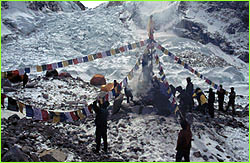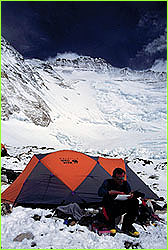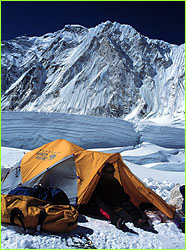 |
 |
 |
 Going Higher: Up to Camp II
Going Higher: Up to Camp IIPage 2 | Back to Page 1 5:30 am is the magic hour, when our team must head out of camp. All have harnesses and plastic double boots, with ice axes in hand and packs loaded for dumping gear up at Camp I. Chyangba, our head cook, has set a juniper branch on fire atop a stone pile and the smoldering smoke rises into the windless air. All move off, forming a clockwise circle around the burning juniper before heading out of camp. Sherpas circle to the left of prayer flags, mani stones, and burning juniper pyres to gain merit in the next life. The Icefall sits in the darkness ahead, as climbers from the many international teams plod along the single path toward its base, hardware clanking with each step. At 6:00 a.m. we have a first radio call from Ed Viesturs, who reports that all is well at Camp II. "It was a little windy last night, but we got enough sleep.  We're going to head up to Camp III to dump a load up there and then will come
back down to Camp II to sleep," reports Ed.
We're going to head up to Camp III to dump a load up there and then will come
back down to Camp II to sleep," reports Ed.The next step of the day is to go into the dining/communications tent to try to retrieve e-mail. I never thought I'd have an office complete with phone, fax, computer, and even a CD player up at Everest Base Camp. Tom Waits croons out a barroom tune as I try to power up the laptop. A strange sound comes from its electronic insides and I have to take the battery out. (Why did I forget to put it in my sleeping bag with me last night?) The battery goes into a ziplock bag for Chyangba to boil for a few minutes in a pot in the kitchen tent. I then take the entire laptop and put it inside my down coat and against my warm (not for long) stomach to heat it up. Minutes later, I reinsert the battery in the laptop and fire it up. "Welcome to Macintosh" finally appears on the screen and we're halfway to getting e-mail. Receiving e-mails requires powering up the satellite phone off of 12-volt car batteries that are powered by solar panels. If that power system fails, we have a small Honda generator that will, unfortunately, wake up our Russian and Canadian neighbors sleeping in tents nearby. Starting the generator in the frigid morning air is always a challenge; when that doesn't work, specially made expedition lithium batteries will give us emergency power in a pinch. Satellite phones are sensitive to power requirements and weather. We've been told that there is a solar shower taking place in the atmosphere that may cause problems in satellite communications. Even though our communications technology may seem high-tech, particularly in such a remote place, communicating is no simple matter. We feel lucky every time we're able to successfully send a file, e-mail, or photographic image. Something can go wrong anywhere along the line, from our power source, phone, laptop, modem, the atmosphere, our satellite service provider, or the landline going back to our ultimate destination—WGBH in Boston.  8:30 am—the words "Camp I to Base Camp," come through loud and clear on the
Motorola base station sitting next to the satellite phone. "Come in Camp I."
"Well we had a beautiful morning through the
Icefall.
There were a lot of people in there with us, but we're now having a
snack to refuel up here and then we'll move on up to Camp II," says David on
the radio. It normally takes about three hours to get through the Icefall with
a moderate load. Given good traffic conditions, our climbing Sherpas, Dorje,
Dorje, and Kami, can make it up to Camp I in a little over an hour. "We're
ready to give you our pulse and oxygen saturation readings," David remarks over
the radio.
8:30 am—the words "Camp I to Base Camp," come through loud and clear on the
Motorola base station sitting next to the satellite phone. "Come in Camp I."
"Well we had a beautiful morning through the
Icefall.
There were a lot of people in there with us, but we're now having a
snack to refuel up here and then we'll move on up to Camp II," says David on
the radio. It normally takes about three hours to get through the Icefall with
a moderate load. Given good traffic conditions, our climbing Sherpas, Dorje,
Dorje, and Kami, can make it up to Camp I in a little over an hour. "We're
ready to give you our pulse and oxygen saturation readings," David remarks over
the radio.Continue Lost on Everest | High Exposure | Climb | History & Culture | Earth, Wind, & Ice E-mail | Previous Expeditions | Resources | Site Map | Everest Home Editor's Picks | Previous Sites | Join Us/E-mail | TV/Web Schedule About NOVA | Teachers | Site Map | Shop | Jobs | Search | To print PBS Online | NOVA Online | WGBH © | Updated November 2000 |